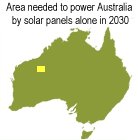“Through partnerships such as Maricopa Solar, we will be able to learn a great deal about this emerging solar technology while helping to create green jobs, economic development opportunities and clean energy for SRP and our customers,” said SRP Associate General Manager Richard Hayslip. “The Maricopa Solar project is just one example of SRP's commitment to building a renewable energy portfolio that is beneficial to our environment and customers.”
The innovative and highly-efficient SES SunCatcher is a 25-kilowatt solar power system which uses a 38-foot, mirrored parabolic dish combined with an automatic tracking system to collect and focus the sun's energy onto a Stirling engine to convert the solar thermal energy into grid-quality electricity.
“The SunCatcher represents the next generation of grid-quality solar power technology providing clean, reliable and cost-effective solar power to address global climate change and reduce our planet's carbon emissions,” said Steve Cowman, Stirling Energy Systems CEO.
SunCatcher has a number of advantages including the highest solar-to-grid electric efficiency, zero water use for power production, a modular and scalable design, low capital cost, and minimal land disturbance. SunCatcher was designed and developed in America, through a public-private partnership with the U.S. Department of Energy. The SunCatchers unveiled at Maricopa Solar were manufactured and assembled in North America, mostly in Michigan by automotive suppliers.
High-volume manufacturing of the SunCatcher begins in Summer 2010 and Tessera Solar breaks ground on utility-scale projects late this year in California and Texas. Imperial Valley is a 750 MW project with the first 300MW contracted under a power purchase agreement with San Diego Gas & Electric near El Centro, California; Calico is a 850 MW project with Southern California Edison near Barstow, California; and Western Ranch is a 27 MW project with CPS Energy in West Texas. Manufacturing of SunCatcher components and construction of these projects will create up to 4,000 jobs in the near term, both in the Midwest, where SES's automotive supply chain base originates, and in the Southwest where projects will be developed.
For more information, visit www.stirlingenergy.com, www.tesserasolar.com, www.ntrplc.com and www.srpnet.com.
PHOTOS AND VIDEO ARE AVAILABLE AT www.srpnet.com/maricopasolar.
About Stirling Energy Systems (SES Inc.)
Stirling Energy Systems (SES) is the global supplier of the SunCatcher� solar dish engine system, the latest innovation in modular Concentrating Solar Power (CSP), and next generation of grid-quality, solar-electric power generation. The SES SunCatcherTM combines a mirrored concentrator dish with a high-efficiency Stirling engine to track, collect and convert the sun's thermal energy to grid-quality electricity. The SunCatcherTM technology has significant advantages over other CSP technology including zero water use for power production, minimal impact to the environment, the highest electric efficiency and cost competitiveness. Founded in 1996, the company maintains corporate headquarters in Scottsdale, Arizona, and engineering and test site operations at Sandia National Laboratories in Albuquerque, New Mexico. NTR owns a controlling stake in SES Inc.
About Tessera Solar
Tessera Solar is the exclusive developer/owner/operator of utility-scale solar power facilities using the SunCatcher� solar power system, manufactured by our sister company Stirling Energy Systems (SES Inc.), headquartered in Scottsdale, Arizona. Tessera Solar North America is headquartered in Houston, Texas, with offices in Scottsdale, Arizona and Berkeley, California. Tessera Solar International is headquartered in London, England. NTR plc is the parent company of Tessera Solar and SES.
About NTR plc
NTR plc, the international renewable energy group, builds and runs green energy and resource-sustaining businesses. Founded in 1978, NTR has evolved from being a developer and operator of infrastructure in Ireland to an international developer and operator of renewable energy (wind, solar and ethanol) and sustainable waste management businesses in the USA, UK, and Ireland. The company employs over 4,100 people.
About Salt River Project (SRP)
Salt River Project is the third-largest public power utility in the country and serves more than 930,000 electric customers through a variety of resources including solar, wind, biomass, geothermal and hydroelectricity. In 2004, SRP's Board of Directors voted to require that 15 percent of the energy generated comes from sustainable resources by 2025. Today, SRP's sustainable portfolio is 6.5 percent of the total power provided to our customers.
For more information, visit www.stirlingenergy.com, www.tesserasolar.com, www.ntrplc.com and www.srpnet.com. ���
Copyright © 2010 Peoria Times.
Home



 FloDesign hasn’t been in hiding; the company previously won a technology competition at the Massachusetts Institute of Technology for its alternate wind turbine design, which departs from the traditional “prop” design of a wind turbine with something that looks a lot more like a jet engine.
FloDesign hasn’t been in hiding; the company previously won a technology competition at the Massachusetts Institute of Technology for its alternate wind turbine design, which departs from the traditional “prop” design of a wind turbine with something that looks a lot more like a jet engine. This one won’t sound too odd at first. Joule plans on putting a microorganism in a pool with nutrients, focusing sunlight on it, and harvesting the resulting oil to use as fuel. Not much different from a greenhouse or plant solarium, right?
This one won’t sound too odd at first. Joule plans on putting a microorganism in a pool with nutrients, focusing sunlight on it, and harvesting the resulting oil to use as fuel. Not much different from a greenhouse or plant solarium, right?